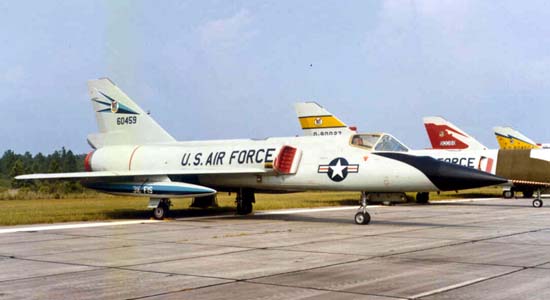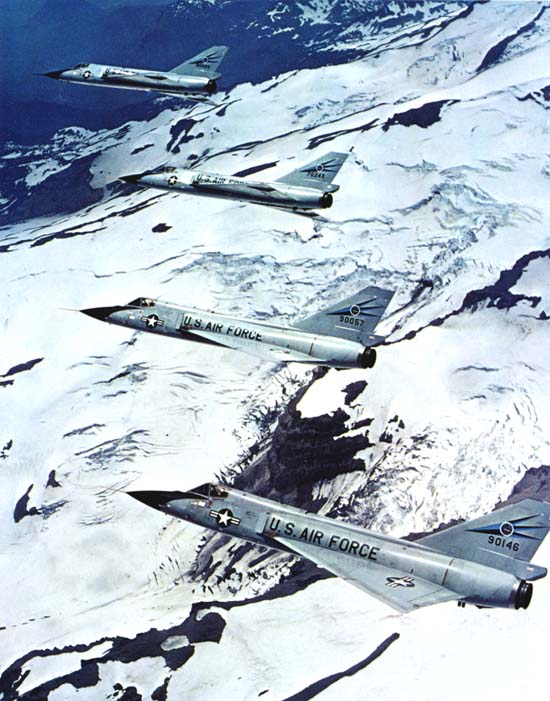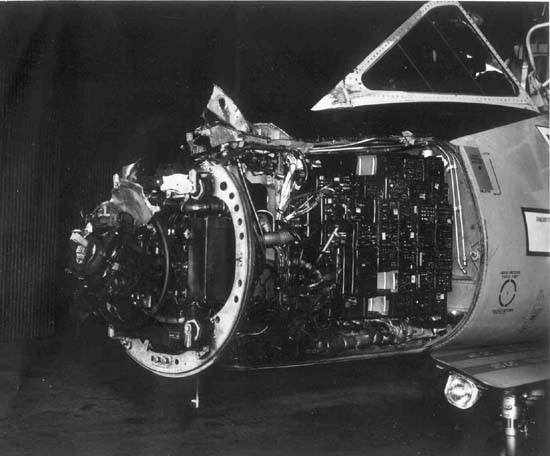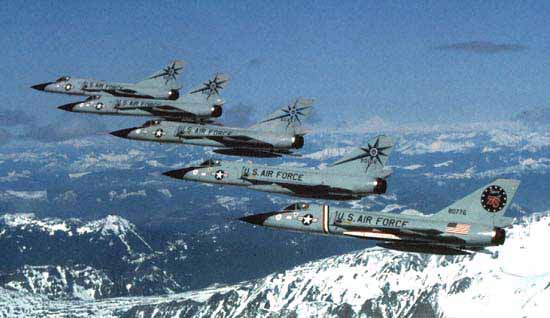|
|
|
THE F-106 ERA (1960 - 1983) |
|
AEROSPACE DEFENSE COMMAND (1968-1979) |
|
|
 |
|
PHOTO FROM "Erv Smalley's & Marty Isham's Convair
F-106 Delta Dart"
www.convairf-106deltadart.com/
|
|
Pictured during a slow day
for squadron "spares" F-106A 56-0459 sit next to aircraft from the 2nd,
87th and 5th Fighter-Interceptor Squadrons during William Tell '72.
|
|
|
|
On 15 January 1968, the
Air Defense Command, a organization that the 318th FIS had been
affiliated for most of its postwar reactivation was redesignated as the
Aerospace Defense Command (ADCOM) as a response to the organizations
growing responsibility of detecting and tracking ballistic missiles and
space satellites.
|
|
|
|
On July 1 1968, the
325th Fighter Wing deactivated and relinquished control of McChord AFB
to the Military Airlift Command's 62d Military Airlift Wing (MAW). The
62d MAW assumed all host unit responsibilities at the Base with the
318th FIS becoming a tenant organization at the Base. With the
deactivation of the 325th FW, the 318th FIS assumed control of the
Walla Walla,
WA
alert site, redesignating Detachment 2, 325th Fighter Wing to Detachment
1, 318th.
|
|
|
|
Late in 1968, the 318th
FIS & the deactivated 325th FW received the Air Force Outstanding Unit
Award for exceptionally meritorious achievement in support of military
operations for the period of June 1967 to March 1968. In what was said
to be a "very close contest", the 318th placed 2nd in the race for the
1968 Hughes Trophy.
|
|
|
 |
|
PHOTO FROM BY KENNETH HACKMAN - USAF |
|
F-106A 59-0065 leads
57-0243, 59-0057, & 59-0146 over Mt Rainer wearing the second tail flash
painted on their Delta Darts.
|
|
|
|
On 23 April 1969,
highly decorated 318th FIS pilot Maj. Clyde Falls, Jr. died in the crash
of his F-106A, s/n 59-0148 (the last F-106 produced). In Southeast Asia,
Maj. Falls spent a little more than one year flying F-105 Thunderchiefs during raids deep in North Vietnam.
For his bravery in combat in the skies of Southeast
Asia, Maj. Falls earned four Distinguished Flying Crosses
fifteen Air Metals and the nation's third highest award for combat
valor, the Silver Star.
|
|
|
|
During the busy
increasing tempo actions in the late 1960, the
Aerospace Defense Command decided against conducting the bi-yearly
William Tell Weapons Meet, but in 1970's, revived the competition to
crown the best fighter-interceptor squadron. Proving again to be one of
the top fighter squadron's in the Air Force, the 318th attended the 1970
& 1972 editions of the Word Wide Weapons Meet placing third in both
competitions.
|
|
|
|
In April
1971, Detachment 1, 318th FIS detachment was on the move, transferring
down the I-5 corridor to neighboring State of Oregon, leaving Walla
Walla, WA and moving to Kingsley Field, OR. This shift was the result of
the transfer of the F-106 equipped 460th Fighter-Interceptor Squadrons
from Kingsley to Grand Forks AFB, ND. The 460th had been only been
reactivated at Kingsley in the F-106 for a little more than one year
before its transfer to North
Dakota.
|
|
|
 |
|
PHOTO FROM "Erv Smalley's & Marty Isham's Convair
F-106 Delta Dart"
www.convairf-106deltadart.com/
|
|
After being strut by
lightning during a test flight, Captain Joe Yurkevicz
from the 318th was able to return his F-106B back to base with out any
further incident.
|
|
|
|
In May of 1971, on a
routine test flight after a engine change, F-106B S/N 59-0152 was struck
by lightning 35,000 feet above Sequim WA, The blast blew off the
aircraft's nose cone and caused significant damage to the forward
section of the interceptor. The pilot, 318th Quality Control Officer
Captain Joe Yurkevicz was unhurt and was able to land the aircraft (with
assistance from two F-106's on alert) without further incidents.
The F-106B S/N 59-0152, was out of commission for 6 months while it
underwent needed repairs at the Sacramento Air Logistics Center in
California. The aircraft did return to the squadron and served until
October of 1983, and later would later become the one of the first
F-106's converted for drone use in 1986.
|
|
|
|
On the day before
Thanksgiving in 1971, a man calling himself "D.B. Cooper" boarded a
Northwest Orient flight in Portland International Airport, OR and once
aloft threatened to destroy the plane if did not receive $200,000
and four parachutes. The plane landed at
Seattle-Tacoma
Airport where the FBI carried out all
of Cooper's demands, hours later the Boeing 727 was refueled and
(absence of passengers) in the air headed to Mexico. A short time later, two
F-106's from the 318th FIS were scrambled with a task to shadow the
hijacked airliner and track its escape to Mexico.
|
|
|
|
While in the air over
Washington and Oregon
Cooper, with the ransom in hand, jumped from the rear of the plane
parachuting into the night and the history books. For many years
following the incident until the close of the squadron, members of the
318th would hold an annual dinner; commemorate this incident and their
role in the mystery of D.B. Cooper.
|
|
|
 |
|
PHOTO FROM KOKU-FAN |
|
Pictured at William Tell '74
s/n 59-0108 can be seen with the ADCOM "A" Award flag applied to the
lower section of it's tail.
|
|
|
|
The 318th was the proud
recipient of the Aerospace Defense Command "A"
award for the period of 1 August 1971 to 31 December 1972. The "A" Award
is given for outstanding accomplishments in operational effectiveness.
The 318th also received their second Air Force Outstanding Unit Award
for 1 January through 31 December 1973.
|
|
|
|
In the spring 1974, the
Squadron deployed to Howard AFB, Panama in support of "Black Hawk '74"
a Joint Task Force exercise designed to evaluate the air defense
capability of the Panama Canal zone.
What is clearly a testament to the effectiveness of the 318th the
squadron participated in their 4th straight William Tell Meet in the
F-106, as they did in 1970 & 1972, the Green Dragons found themselves in
third place.
|
|
|
|
The Green Dragons
outstanding performance during 1974 and 1975 earned the most prestigious
award for an Air Force Squadron with an air defense mission, the Hughes
Trophy. A runner up for many years the 318th became the third Squadron
of the 25th Air Division to win the award. Since 1953, the prestigious
award has been given by the Hughes Aircraft
Company the finest air defense fighter unit in the World of
a particular year. On 24 January 1976, Gen Daniel "Chappie" James,
Commander of Aerospace Defense Command presented the award to the Green
Dragons along the squadron flightline. The day also marked the debut of
the 318th specially painted F-106 commemorating the United States 200th birthday. The
aircraft name "The Freedom Bird" (s/n 58-0776) was a very popular chose
for many air shows around the country.
|
|
|
 |
|
PHOTO by gene Johnson |
|
New tail flashes graced the
aircraft of the 318th including F-106A 58-0776 named "The Freedom Bird"
specially painted for the Nations Bicentennial.
|
|
|
|
In 1976, the 318th FIS
received a third Outstanding Unit award for the period of July 1974 -
June 1976, and their second ADC "A" Award for 1976. After a long string
of good news, the Green Dragons found themselves in an unfamiliar place.
For the first time since the unit converted into the F-106 the "Green
Dragons” failed to qualify for the 1976 edition for the William Tell
Weapons Meet. Since the competition was recreated at Tyndall AFB in
1958, the 318th has participated in six of the eight weapons meets held
through 1976.
|
|
|
|
An example of a lower
key, but important missions performed by the 318th was the "high speed
airlift" mission. In 1977, a squadron F-106 was used to rush rattlesnake
bite serum to save the life of a 16 year old snake bite victim in
Alaska, two years later F-106s flew smallpox vaccine to Norton AFB, CA
to save the life of a airman from that base.
|
|
|
|
Next Page: F-106 Era - Tactical Air
Command (1979-1983) |
|
|
|
|
 |